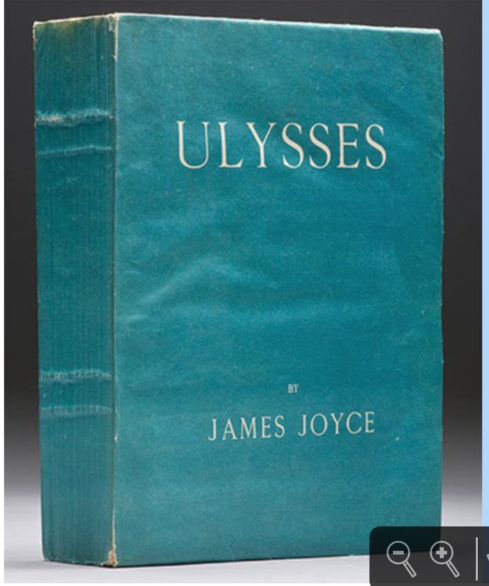~~~~~~~~~~~~~~~~~~~~~~~~~~~~~~~~~~~
The Morgan Library & Museum Celebrates
One Hundred Years of James Joyce’s Ulysses
~~~~~~~~~~~~~~~~~~~~~~~~~~
New York, NY (May 11, 2022) – To mark the centenary of the groundbreaking novel’s first edition, the Morgan Library & Museum presents One Hundred Years of James Joyce’s “Ulysses,” opening June 3 and running through October 2, 2022. Curated by the noted Irish author Colm Tóibín, the exhibition explores the trajectory of Joyce’s life and career from lyric poet to modernist genius and illuminates the author’s creative process through rare publications, portraits, correspondence, manuscripts, plans, and proofs—many of which are reunited for the first time in a century. It considers key figures from Joyce’s biography that inform the creation of Ulysses, such as Joyce’s father, John Stanislaus Joyce, and his wife, Nora Barnacle, as well as those instrumental in realizing its publication: Harriet Shaw Weaver, Margaret Anderson, Ezra Pound, and Sylvia Beach. The exhibition also looks at artists and writers who responded to the novel, as well as the censorship that attended its publication in the US.
———————

Berenice Abbott (1898–1991), James Joyce, 1928. The Morgan Library & Museum, New York,
gift of Sean and Mary Kelly, 2018; 2018.20. © Berenice Abbott via Getty Images
———————
Ulysses was first published in book form on February 2, 1922. Set on one day—June 16, 1904—the novel follows the young poet Stephen Dedalus and the unlikely hero Leopold Bloom on a journey through Dublin. The landmark work links the epic to the ordinary, connecting characters and motifs from Homer’s ancient Greek poem the Odyssey with everyday life in Joyce’s hometown. Written in self-imposed exile between 1914 and 1921 in Trieste, Zurich, and Paris, Ulysses invokes the atmosphere and the topography of 1904 Dublin in astonishing and meticulous detail. On its publication in Paris a century ago, the novel expanded the limits of language and genre—and not without controversy. Censored and banned in America and England for obscenity, Ulysses became the catalyst for new legal standards of artistic freedom.
One Hundred Years of James Joyce’s “Ulysses” draws on items from the Morgan’s Sean and Mary Kelly Collection, including inscribed copies of the author’s works, rare publications and broadsides, a manuscript fragment, and Joyce’s typewritten schema of the Homeric structure of Ulysses. Major contributions from the James Joyce Collection, University at Buffalo, The State University of New York, and additional institutional loans include the first and last pages of the manuscript, proofs on which part of the novel was written, and rarely seen letters between Joyce and Nora Barnacle. Also featured are textual and visual responses by figures such as Virginia Woolf, George Antheil, Henri Matisse, Vladimir Nabokov, and Ralph Ellison.
—————
The Morgan’s Director, Colin B. Bailey, said, “The 2018 gift to the Morgan of the Sean and Mary Kelly Collection of James Joyce has inspired this project, enabling us to celebrate one of the most daring and controversial literary works in the English language. I can think of no one better to spearhead our efforts than Colm Tóibín, who, among many other accomplishmenbts, is a leading expert on Joyce.”
—————

James Joyce, Ulysses, Paris: Shakespeare and Company, 1922.
Gift of Sean and Mary Kelly, 2018; PML 197791
—————
The exhibition is guest curated by Colm Tóibín and co-organized with Sheelagh Bevan, Andrew W. Mellon Associate Curator, Department of Printed Books and Bindings, and Philip S. Palmer, Robert H. Taylor Curator and Department Head, Literary and Historical Manuscripts.
Accompanying the exhibition is a fully-illustrated volume of essays co-published by the Morgan and Penn State University Press. Edited by Colm Tóibín, this book presents work by preeminent Joyce scholars and representatives of the major manuscript collections, as well as an interview with Sean Kelly, who, with his wife Mary, donated their extensive Joyce collection to the Morgan. Tóibín’s expert interpretation of the Dublin context for Ulysses precedes writings that treat Joyce’s life in Trieste, Zurich, and Paris from 1914 up through the novel’s publication, drawing on notebooks and letters, as well as extant manuscripts and proofs. Along with the editor, includes contributions by Ronan Crowley, Maria DiBattista, Derick Dreher, Catherine Flynn, Anne Fogarty, Rick Gekoski, Joseph M. Hassett, James Maynard, John McCourt, and Curator Emeritus John Bidwell, who organized the publication for the Morgan.
——————
Colm Tóibín
A native of southeastern Ireland, Colm Tóibín is the author of ten novels, including The Master (2004), Brooklyn (2009), and, most recently, The Magician (2021). He has frequently written on Joyce, in books such as Mad, Bad, Dangerous to Know: The Fathers of Wilde, Yeats and Joyce (2018). Tóibín’s work has been translated into more than thirty languages. He is a Contributing Editor at the London Review of Books and the Irene and Sidney B. Silverman Professor of the Humanities at Columbia University, where he taught a seminar on Joyce this past spring. In 2017, he co-curated Henry James and American Painting at the Morgan Library & Museum.
—————
One Hundred Years of James Joyce’s “Ulysses”
June 3 through October 2, 2022 The Morgan Library & Museum 225 Madison Avenue at 36th Street New York, NY 10016
—————
Organization and Sponsorship
One Hundred Years of James Joyce’s “Ulysses” is made possible by The Pierre and Tana Matisse Foundation, the Government of Ireland, the Lucy Ricciardi Family Exhibition Fund, and the Drue Heinz Exhibitions and Programs Fund. Additional support is provided by the Themis Anastasia Brown Fund and the Dedalus Foundation.
~~~~~~~~~~~~~~~~~~~~~~~~~~~

A museum and independent research library located in the heart of New York City, the Morgan Library & Museum began as the personal library of financier, collector, and cultural benefactor Pierpont Morgan. The Morgan offers visitors close encounters with great works of human accomplishment in a setting treasured for its intimate scale and historic significance. Its collection of manuscripts, rare books, music, drawings, and works of art comprises a unique and dynamic record of civilization, as well as an incomparable repository of ideas and of the creative process from 4000 BC to the present.
—–
The Morgan Library & Museum | 225 Madison Avenue | 212.685.0008 | themorgan.org
——————————-
View: AAQ / Museum Architecture / Morgan Library & Museum
——————

AAQ / Resource: Riverhead Toyota
___________________________________________________________________________

